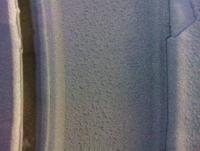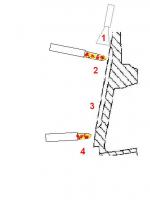02-16-2009, 09:53 AM,
|
|
|
landemarre

Active Member
   
|
Posts: 33
Threads: 2
Joined: Jul 2008
Reputation:
2
| |
RE: Crack line
(02-13-2009, 10:01 AM)ykang Wrote: Dear Gordon & Fellows:
I am doing some abradable coating spraying with SM 3MB gun on production part. We observed non-uniform coating build-up at the radius corner (which relatively faster than the flat surface) and it resulted thicker coating built-up at this area, which caused non-uniform coating coverage (a joint-line can be seen even before machining) and the crack lines after machining (refer to photo).
From my perception, it could be caused by the robot arm program movement, but we have no idea to resolve the problem. Could anyone advise on it?
Thank you very much
Regards;
Ykang
Yes this is possible. Do you have create a tool robot for your 3MB that should be intersection with substrate and plasma jet? This is need to have correct speed but it can be not enough and perhaps you should change gun orientation before the change of direction on your piece to help the robot. Perhaps you could add some air jet where you have troubles.
Good luck.
|
|
|
02-17-2009, 01:29 PM,
|
|
|
jdulgerska

Member
  
|
Posts: 6
Threads: 1
Joined: Feb 2009
Reputation:
0
| |
| RE: Crack line
Hi All,
Does anyone know where I can find a wet cleaning procedure for Ti substrates?
Many Thanks,
Juliana
|
|
|
02-18-2009, 07:18 PM,
(This post was last modified: 02-18-2009, 07:23 PM by TurbineRepair.)
|
|
|
TurbineRepair

Senior Member
    
|
Posts: 75
Threads: 20
Joined: Jun 2008
Reputation:
2
| |
RE: Crack line
Hi Juliana,
What exactly do you mean by wet cleaning? Degrease or heavy clean? J84A from CeeBee UK can be used on Ti in a relatively mild solution, works well too.
Jim
(02-13-2009, 10:01 AM)ykang Wrote: Dear Gordon & Fellows:
I am doing some abradable coating spraying with SM 3MB gun on production part. We observed non-uniform coating build-up at the radius corner (which relatively faster than the flat surface) and it resulted thicker coating built-up at this area, which caused non-uniform coating coverage (a joint-line can be seen even before machining) and the crack lines after machining (refer to photo).
From my perception, it could be caused by the robot arm program movement, but we have no idea to resolve the problem. Could anyone advise on it?
Thank you very much
Regards;
Ykang
Hi Ykang,
Its odd that you are only getting this problem on one side of the C section. What is happening at the top? Is it getting a bit hot and cracking when it contracts as landemarre suggests? There does seem to be more material to absorb the heat on the top of your drawing.
Jim
|
|
|
02-19-2009, 09:54 AM,
|
|
|
jdulgerska

Member
  
|
Posts: 6
Threads: 1
Joined: Feb 2009
Reputation:
0
| |
| RE: Crack line
Hi Jim,
I mean not mechanical cleaning.May be acid solution for Ti targets.
Juliana
|
|
|
02-20-2009, 10:26 AM,
(This post was last modified: 02-20-2009, 10:45 AM by TurbineRepair.)
|
|
|
TurbineRepair

Senior Member
    
|
Posts: 75
Threads: 20
Joined: Jun 2008
Reputation:
2
| |
RE: Crack line
Hi Ykang,
As Karunanidhi says it must be down to your spray method. The part geometry doesn't look to bad with nicely radiused corners. What powder/gun are you using? It could be that you are applying the coating to thickly? What is your turn table/traverse speed and part diameter? I've found it certainly helps to stick closely to the recommended surface speed and step height, which for plasma should be surface speed of 75m/min and a step height of 5mm per revolution.
Are you able to move the gun at 90o to the job and move all the way through the diameter? A shallow spray angle and dwelling at the bottom edge might cause a problem. Also, if the part getting up to temperature during preheat?
Jim
Hi Juliana,
I'm no chemist and I can only comment on the methods we use here, but I do find the light duty alkaline cleaning solution of J84A (Supplied by McGean-Rohco Inc) or Turco 4181 is good for general cleaning. We have, on occasion used a acid strip solution for removing heat scale and oxide formation. This method needs a heated stainless tank (85o) and Turco Scale Gon 5 solution mixed with water. I'm not sure off hand what this stuff is but it seems to do the trick  Dunk your part in for 15-30 mins then rinse.
Jim
|
|
|
02-20-2009, 11:34 AM,
|
|
|
jdulgerska

Member
  
|
Posts: 6
Threads: 1
Joined: Feb 2009
Reputation:
0
| |
| RE: Crack line
Hi Jim,
I will try!
Thank you!
Juliana
|
|
|
02-26-2009, 02:31 AM,
|
|
|
Gordon

Administrator
|
Posts: 1,802
Threads: 70
Joined: Jun 2006
Reputation:
9
| |
RE: Crack line
Hi Juliana
I have formed a new thread wet-cleaning-procedure-for-ti-substrates-split-t-734.html for your topic, as I think two different topics occupying the same thread a little confusing and does not help with searches.
Please go to new thread for replying to wet-cleaning-procedure-for-ti-substrates topic. I will try to edit this thread later when everybody gets their bearings 
|
|
|
03-03-2009, 11:31 AM,
(This post was last modified: 03-03-2009, 11:33 AM by ykang.)
|
|
|
ykang

Active Member
   
|
Posts: 31
Threads: 10
Joined: May 2008
Reputation:
2
| |
RE: Crack line
Dear All:
I wish to get the helps from you again. I'm still unable to resolve the 'crack line' as explained. I have done the following actions, it was getting better, but the 'delamination line' still couldn't be removed completely.
Things have been done:
1. Change the gun angle, so that it is perpendicular to the coating surface.
2. Change the gun speed, so that the gun moves fast across the radius corner.
3. Reduce the feedrate from 35g/min to 25g/min to get rid of the rough & lumpy surface (it did help to reduce it, but when the coating built-up to certain thickness, the problem came back again)
4. Reduce the carrier gas from 7.5l/m to 6.0l/m, as reason in point 3.
From my perpective, there could be 2 reasons to cause the 'crack line': First was due to the build-up rate at the corner radius area while second one was caused by the rough surface, because it caused the coating build-up in different 'level'. However, the corrective actions seemed not working well.
Therefore, I am seriously seeking for your suggestion and help in order to solve this problem.

Coating after 15 cycles with 25g/min, 6.0 l/m Ar. It looked good at this stage, but when the cycles increased, the 'crack line' became more obvious.
Thank you very much
|
|
|
03-04-2009, 05:27 PM,
|
|
|
Gordon

Administrator
|
Posts: 1,802
Threads: 70
Joined: Jun 2006
Reputation:
9
| |
| RE: Crack line
Hi Ykang,
A few questions: What is abradable coating? Bond coat used? Max coating thickness around problem area? Can you provide sketch as to what's happening in the cross-section view (crack route)?
The only other things I can suggest that have not already been mentioned:
Increase ventilation to the spray area to reduce the dust and over-spray material, that typical flies around in confined areas.
Start spraying from the bottom up rather than top down. Less chance for debris to collect in fillet area. May be worth trying to make all spay passes in upward direction only.
|
|
|
03-05-2009, 08:23 AM,
|
|
|
ykang

Active Member
   
|
Posts: 31
Threads: 10
Joined: May 2008
Reputation:
2
| |
RE: Crack line
Hi Jim:
No temperature is monitoring, but there are 4 cooling siphon jets directed to the coating. Yes there is the fixture 'close' to the radius area, but with 20mm away from it.
Hi Gordon:
It is METCO 601 powder with Amdry 956 bond coat. So far bond coat gave perfect bonding (at the radius) with same robotic arm movement and speed. Thickness required for final coating is 0.130", cant really tell you what is the thickness at the problem area, as I do not measure the thickness from that point.

Point 1 ~ 4 are spray gun moving path. Gun is changing with the part configuration. I wish to know if the cooling siphon jet is positioned at sketched location, does it help to remove the powder dust?
Thanks
|
|
|
03-09-2009, 04:35 PM,
|
|
|
Gordon

Administrator
|
Posts: 1,802
Threads: 70
Joined: Jun 2006
Reputation:
9
| |
RE: Crack line
Hi Ykang,
Quote:No temperature is monitoring, but there are 4 cooling siphon jets directed to the coating. Yes there is the fixture 'close' to the radius area, but with 20mm away from it.
Knowing the thermal history of coating/substrate during the process is an important aspect of thermal spraying. I would suggest careful monitoring at least during the initial job set-up.
From your sketch, I would suggest:
1. Change gun angle so that it is a bit more favourable to the radius area.
2. Start spraying from bottom to top ie reverse direction.
Quote:I wish to know if the cooling siphon jet is positioned at sketched location, does it help to remove the powder dust?
Difficult to tell without actually watching the process. I think you need to watch the process and experiment with siphon jet positions and initially go by what looks best.
Another question: Are you using the recommended gun air cooling jets (parallel, 75 psi)?
|
|
|
03-12-2009, 10:44 AM,
|
|
|
ykang

Active Member
   
|
Posts: 31
Threads: 10
Joined: May 2008
Reputation:
2
| |
RE: Crack line
Hi Gordon:
Gun air cooling jets parallel, 4 bar
Would you please explain a bit more how to "Change gun angle so that it is a bit more favourable to the radius area" ? Does it mean that the gun is 90 deg to the radius?
One question to ask: Do you think the coating too "hard" (but still within spec range) will cause this problem? We had tried to 'soften' the coating, but it did not help much. 
Many Thanks
|
|
|
03-12-2009, 08:12 PM,
|
|
|
Gordon

Administrator
|
Posts: 1,802
Threads: 70
Joined: Jun 2006
Reputation:
9
| |
RE: Crack line
Hi Ykang,
Quote:Would you please explain a bit more how to "Change gun angle so that it is a bit more favourable to the radius area" ? Does it mean that the gun is 90 deg to the radius?
Yes, but obviously it would have to be a compromise between radius and adjacent surfaces. The weak point would appear to be right at the point where the spray angle is at its lowest at the peak of the radius.
Quote:One question to ask: Do you think the coating too "hard" (but still within spec range) will cause this problem? We had tried to 'soften' the coating, but it did not help much. Sad
No, I don't think so. Hardness of this coating predominantly depends on amount of polyester in coating.
|
|
|
|


 SEF Portal
SEF Portal Search
Search Member List
Member List Calendar
Calendar Help
Help



 Dunk your part in for 15-30 mins then rinse.
Dunk your part in for 15-30 mins then rinse.